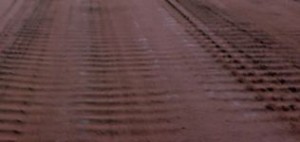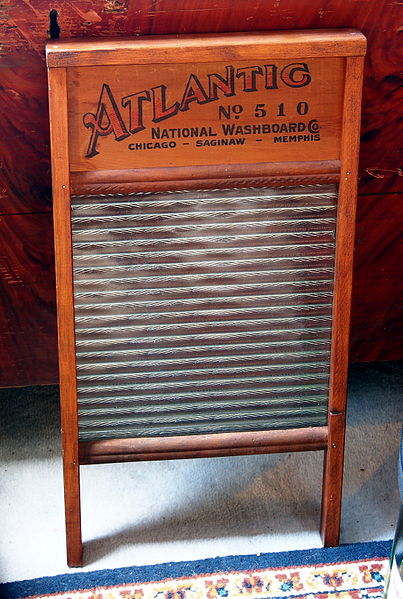 What is a washboard road? And what causes one?
What is a washboard road? And what causes one?
No doubt you’ve ridden gravel roads that made feel like you were driving across a washboard. You felt like you were being shaken to pieces. Then you noticed the road’s parallel ridges and grooves.
Each groove was two or three inches from the next one. You slowed your speed to reduce the vibration and thought, “What causes washboard road surfaces, anyway?” Many previous to you have asked this same question.
Washboard roads are miserable to travel. Car control suffers from lack of road contact. Accidents result.
One Common Explanation for Washboard Road
Some suggest1 it is a vehicle’s suspension system that causes seeming random forces to change into a harmonic, feedback pattern that results in compactions (or valleys) and upward displacements (or crests). According to this theory, vehicles traveling roads along such a surface must have their velocity adjusted to reduce bouncing, increasing comfort.

Some Researchers Disagree
Laboratory tests suggest the above mechanism does not truly portray the origin of washboard road surfaces.2 Rather, they can be produced without a suspension or even wheels. Unfortunately, what actually does produce the effect has not been released from the findings. Presumably, we must wait a while for a suitable explanation.
Author’s Remarks
Although my education was in the field of chemistry rather than of physics, I have a theory I’d like tested. Does travel by car or other vehicle produce sufficient horizontal force that it makes gravel surfaces at point of contact behave like a solid wall? And does the wheel or other device then climb that wall, then sink to repeat the process?
1 The Straight Dope: What causes the “washboard” effect on unpaved roads?
2 Washboard Road: The Dynamics of Granular Ripples Formed by Rolling Wheels
Note: You might also enjoy What is Red Clay?
References:
- Accelerating Through a Resonance on a Washboard Road
- University of California, Berkeley: Tech Transfer Newsletter, Winter 2004

I have read some interesting theories on how corrugations are caused. What is the solution, short to medium term, without tarring or concreting the surface? [Do you have] any comment on my following suggestion? Run a light disk over the surface to break [up] the “waves”, grade [the road] but shape [it into] a convex shape, apply[ing] agriculture lime to eliminate clay particles [from] the surfacing material, [then] wet it and roll it with a heavy roller? If speed has anything to do with the cause, what would the recommended speed be?
I live in the Australian Outback and corrugated roads are a constant problem. I’ve read many of the theories and subsequent experiments to back the theories but they are all based on vehicular traffic as the probable cause. However I was recently a passenger on a very rough, gibber (rock) strewn track on a property. The driver was outback born-and-bred — ‘bushie’ — as we drove in the cool of the early morning. He made the comment that the tracks were always smoother in the mornings and were at their worst in the mid to late afternoons. His logic was based on the cooling-heating process happening. During the heat of the day when the ground temperature can be 60 degrees plus and the rocks and pebbles and soil heat up, they expand and ‘ruffle’ the surface. As everything cools down there is a significant subsidence as all the materials cool, and thus by the morning the surface/track is smoother.
If there is any truth to this it would also explain – perhaps – why graded and flattened roads with certain soil conditions become corrugated, not just where wheels have traversed but where the corrugations extend to the sides of the road where wheels do not travel.
So my question is could there be some truth to the expansion/ contraction in the soil that assists in making these corrugations.
We also see these corrugations occurring in the red sand hills that many say are created by wind, but anyone who has experienced these red sun soaking sand hills knows, that during the heat of the they become unbearably hot and during the night become very very cold and are not touched by rubber!
I would love to hear comments about my ‘bushie’ friend’s theory.
Re: C Gimblett “bushie friend theory”. Personally, I think it has merit. The heat and contraction of a traveled (causing compaction) road has logic.
I like that theory and wish to add it to my theory of: harmonics generated through the drive-line originating from the engines pistons being driven down by individual explosions which would cause pulsations to eventually get to the rubber tire/dirt road contact “ON WHICH” the expansion/contraction theory could be added. HMMMMMM?
Thanks for your comments – much appreciated. The ‘dirt’ roads are serviced by graders and in most cases are formed with the centre being higher than the sides but are not rolled as the distances can be vast as to make it unpractical. I did not mention in the original post regarding the corrugated parts that a lot occurs on either side of grids and braking is required to cross them and is obviously caused by that factor. However braking doesn’t explain the many areas where it happens.
I’ve been told a transmission could cause the washboard effect on dirt roads. Is that true or false? Thanks.
Hi, Donna… It is most unlikely, as statistically, transmission shifts would occur at random points.
I want to know if the vehicle speed affects the rate of formation of corrugations (washboard).
The motor grader puts washboard in the road! When the blade is too straight and they travel too fast the machine bounces on its air filled tires causing washboard. Some operators are very good at avoiding this, some not so much!
I will make a comment, of no greater or lesser importance than any other here. I believe washboard formation is related to wave propagation in a viscous medium. That medium is not easily defined, even as soil particle size, shape, and packing properties are not easily defined. Clouds sometimes assume a ripple shape. Pressure affects wave transmission. This seems to be the approach in the Princeton reference.
Simply put, these waves exist in dunes and on beaches where the only affect is the wind. I believe the washboard is not created by bouncing at the suspensions on vehicles but merely the draft produced by the vehicle dragging the wind along its path. Ron Turner California.
Interesting thoughts! The wind produces some clouds that are suggestive as washboard road. And I suspect some portions of the bottom of the oceans exhibits a similar appearance. Of course loose sand requires a lot less energy to shift, and washboard roads, if plowed and regraded, return before all that much time passes. So something other than wind may be producing the waves, I would suggest. The old “every action has an equal and opposite reaction” bit at work?
It is a feedback-loop. It occurs on any surface over which other things move repeatedly. We can thank the phenomenon for violin-music and for the wavy distortions in the cut of a bandsaw on wood.
I’ve noticed that washboard is always worse on uphill gradients and often only on the side of the road where traffic is headed uphill. Tires slip and start to bounce.
I work at a place that test tires for durability, I maintain the dirt roads (3 mile circle tracks) that are test surfaces and I have seen the corrugation all the way on the shoulders of the road, the larger the vehicle, the faster it happens. I have a theory that the more air a vehicle pushes away the more comes crashing back to close the void, like a collapsing air bubble and if you have real fine powder you can see it start the formation before you can feel it, just like the ripples in the desert are made with out vehicles, I have discussed it with the engineers and they always start rattling off suspension theory but we don’t drive on the shoulders.
My 2 cents.